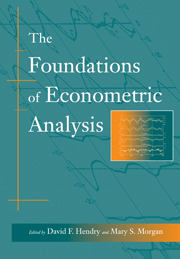Book contents
- Frontmatter
- Contents
- Preface
- Acknowledgements
- Introduction
- Bibliography
- I The Emerging Role of Econometrics in Economics
- II Early Time-Series Analysis
- III Applied Econometrics and the Identification Problem
- IV The Evolution of Statistical Thinking in Econometrics
- V Dynamic Models
- VI The Tinbergen Debate
- 33 Statistical Testing of Business Cycle Theories: A Method and its Application to Investment Activity (League of Nations, Geneva, 1939, vol. I, pp. 34–43, 47–64)
- 34 Professor Tinbergen's Method (Review of Tinbergen (1939), vol. I, Economic Journal vol. 49, 1939, pp. 558–68)
- 35 Mr Keynes on the Statistical Verification of Business Cycle Theories (unpublished, 1940)
- 36 Econometric Business Cycle Research (Review of Economic Studies, vol. 7, 1940, pp. 73–80)
- 37 Autonomy of Economic Relations (League of Nations Memorandum, 1938) and J. Tinbergen's reply (both unpublished)
- VII Structure and Simultaneity
- VIII The Probabilistic Revolution
- IX Exogeneity
- Index
33 - Statistical Testing of Business Cycle Theories: A Method and its Application to Investment Activity (League of Nations, Geneva, 1939, vol. I, pp. 34–43, 47–64)
Published online by Cambridge University Press: 05 June 2012
- Frontmatter
- Contents
- Preface
- Acknowledgements
- Introduction
- Bibliography
- I The Emerging Role of Econometrics in Economics
- II Early Time-Series Analysis
- III Applied Econometrics and the Identification Problem
- IV The Evolution of Statistical Thinking in Econometrics
- V Dynamic Models
- VI The Tinbergen Debate
- 33 Statistical Testing of Business Cycle Theories: A Method and its Application to Investment Activity (League of Nations, Geneva, 1939, vol. I, pp. 34–43, 47–64)
- 34 Professor Tinbergen's Method (Review of Tinbergen (1939), vol. I, Economic Journal vol. 49, 1939, pp. 558–68)
- 35 Mr Keynes on the Statistical Verification of Business Cycle Theories (unpublished, 1940)
- 36 Econometric Business Cycle Research (Review of Economic Studies, vol. 7, 1940, pp. 73–80)
- 37 Autonomy of Economic Relations (League of Nations Memorandum, 1938) and J. Tinbergen's reply (both unpublished)
- VII Structure and Simultaneity
- VIII The Probabilistic Revolution
- IX Exogeneity
- Index
Summary
Chapter III Fluctuations in Investment
The Relation Tested
In this and the two following chapters, a number of the results obtained in applying the method described above to one of the central relations in business-cycle theory will be discussed. The relation in question may be defined as that indicating the ‘proximate’ objective causes of changes in investment activity, looked at from the demand side – i.e., from the side of investing entrepreneurs and public authorities.
Calculations have been made for investment in general, as well as for residential building and railways as important special cases.
As emphasized in chapter I, the principles underlying the procedure are that economic theory has to suggest the factors to be considered, while the statistical testing process shows the maximum degree of accordance obtainable and the relative strength of each factor required to obtain the degree of accordance.
For the investigation of investment in general, the choice of the relevant factors has been based on the following considerations. Total investment activity is the sum of the investment activity of those individual entrepreneurs who decide to invest at all. The larger the number, the greater in general will the volume of investment be. Whether or not an entrepreneur decides to invest depends first of all on whether he expects to make profits or not. Therefore, the number of entrepreneurs planning investment will depend on profit expectations.
- Type
- Chapter
- Information
- The Foundations of Econometric Analysis , pp. 361 - 381Publisher: Cambridge University PressPrint publication year: 1995
- 1
- Cited by

